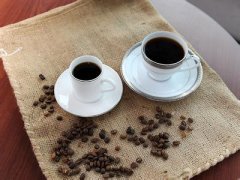Boutique coffee beans common sense Hawaiian coffee
Located south of the Tropic of Cancer and spanning latitudes of 19 to 22 degrees, the Hawaiian Islands are unique coffee-growing areas. Hawaii is the 50th state in the United States, 2400 miles from the west coast of the United States, and is the only state in the United States that produces coffee. The coffee produced in Hawaii is famous all over the world and is regarded as one of the best in the world.
Hawaii has volcanic soil and tropical climate, suitable humidity and regular afternoon showers, which create an ideal planting environment that can only appear in idyllic poetry, and add delicate and unique flavor to the coffee beans here. In general, Hawaiian coffee has a medium consistency and a moderately strong aroma, which is in harmony with its bright acidity. David Kingman, head of Kona Mist, a roaster and retailer on the Big Island of Hawaii, said: this is definitely the best coffee in the world, with drupe and chocolate flavors, and it tastes smooth and delicious.
Although Hawaii has superior growing conditions, historically, the road to coffee cultivation in Hawaii has been very rugged, and its development has not been taken seriously from the very beginning. It was not until 15 years ago that the coffee industry in Hawaii began to take off. Although many people wanted to take advantage of Hawaii's unique geographical conditions to grow coffee commercially and make a profit from it two hundred years ago, they ended up learning only painful lessons!
In 1825, the merchant ship H.M.S. Blonde left gloomy England for Sandwich Islands on the other side of the world, carrying the bodies of King Kamehameha II and the Queen, who died of measles during a visit to London. Sheriff Chief Boki of Oahu, an accompanying official, decided to escort their bodies back to their distant homeland. On the way back, he recruited a man named John Wilkinson to join them on the journey. While in London, Chief Boki bet on a fashion at the time-cafes, and Wilkinson was a coffee expert.
Wilkinson spent several years supervising the cultivation of coffee and sugar in the West Indies. Sheriff Chief Boki believes that with Wilkinson's professionalism, he will be able to develop a piece of fertile land in the Manoa Valley behind his hometown Honolulu into the first ideal commercial coffee growing area in Hawaii. During a short stay in Brazil, Wilkinson picked out some coffee seeds and planted them as soon as he returned to Hawaii. But two years later, just as the coffee tree was maturing, Wilkinson gave up, leaving the visionary coffee garden unmanaged.
From many similar examples, we can see the possibility of the development of the coffee industry in Hawaii. Coffee trees continue to be transplanted to other valleys or other islands on the island, and before long, coffee trees have been planted on almost all the major islands in Hawaii. Coffee trees were initially popular as exotic horticultural plants, not for commercial use. Many people just planted one or two coffee trees in their backyards. It took twenty years to try to plant a large number of coffee trees for commercial purposes. This second attempt was in 1841 AD when a thousand acres of coffee plantations were developed in the Hanalei area of Kauai Island to grow coffee trees transplanted from the Manoa Valley. Three years later, the coffee farm first exported Hawaiian coffee beans abroad, with a quantity of only 245 pounds. Since then, production has increased, but still in small quantities. Although there were still attempts and failures, by 1870, Hawaii's coffee bean exports had reached 415000 pounds.
Just as the coffee crop gained a foothold on the island and became a major crop, the tragedy happened again: there was a major drought and insect pests, so the Hanalei coffee plantation was forced to close in 1855. Although the coffee plantations on the big island seem to have better planting conditions than the lower Hanalei, the big island also suffered great losses due to the white shell pest white scale blight.
In the 1890s, people finally found a prescription for the eradication of diseases and insect pests. They introduced the Australian lady bird beetle to fight the diseases and insect pests of coffee trees, so the coffee growing industry on the big island is booming again. However, with the ups and downs of international coffee futures prices and the impact of overproduction, many large coffee farms closed down because they were unable to cope with drastic changes in the economic environment, and large coffee farms were soon replaced by small farms with an average of less than five acres of land.
In the 1930s, there were more than 1000 small coffee farms on the Big Island; by the 1950s, 6000 acres of coffee woodland in the Kona region of the Big Island produced coffee beans, and by the turn of the century, almost all of Hawaii's major islands were covered with coffee trees. Today, more than 100 years later, the coffee industry has revived on all Hawaiian islands, growing coffee throughout the state of Hawaii.
Even today, some factors beyond human control can still adversely affect coffee cultivation in Hawaii. For example, due to frequent sudden rainfall on the big islands, the climate on other islands is unusually dry. According to the Hawaiian Department of Agriculture, total coffee bean production in Hawaii fell by 13% in the 2001-2002 season, and coffee bean exports totaled 7.6 million pounds, down from 8.7 million pounds in the previous quarter.
All the islands of Hawaii have coffee trees for commercial use. The Big Island has the largest number of coffee farms, with about 650 farms, but these coffee farms are relatively small, with a total of less than 2000 acres. There are only 25 coffee farms operating on the islands of Maui, Molokai, Oahu and Kauai, but the area of coffee farms in these places is much larger than that on the island. The total output is also more than three times higher than that of the Big Island Coffee Garden. Surprisingly, Kauai Island has the largest coffee-growing area of any island, with more than 4000 acres, but all are managed by the same operator; Molokai Island has only 550 acres of coffee, and Maui and Oahu are even less. Most Hawaiian coffee farmers still pick fresh coffee cherries for sale today, but in recent years more and more people are committed to adding value to their coffee bean products, processing, drying, grinding and roasting their own coffee beans.
The most famous coffee bean and coffee producing area in Hawaii is Kona. This area is located in the southwest of the island, 20 miles long and 2 miles wide, covering the slopes of Hualalai and Mauna Loa. Only coffee beans grown in this area and subject to the strictest certification standards can be sold under the brand name Kona. At present, about 100 farms produce coffee beans that meet the above standards, and more and more farms are expected to follow suit in the future.
Norman Sakada, president of the Kona Coffee Culture Festival, said: 60% of the coffee farms in Kona have been up to standard in the past 10 years. "Kona" Chateau Coffee is now a bit like the winery in Napa Valley. The Napa Valley mentioned here is a wine region located in Northern California. Because the wines in this region have excellent regional characteristics, they are internationally recognized and are worth paying more for.
Coffee grown in other parts of the island is collectively referred to as "Hawaiian Coffee". As the price of Kona coffee has soared over the past few years, it has set an example for island residents to know how popular and profitable coffee is from Hawaii. As a result, coffee trees are becoming more and more popular in other parts of the island.
The coffee planting area on the west coast of the island is gradually expanding, and the areas where sugar cane was originally grown are declining because of the low production costs in other countries. The owners of these lands abandon the crops that have won by quantity in the past, and choose to plant crops with high quality and high profits. In this wave, three new coffee producing areas Kau, Hamakua and Puna, which have been recognized by the Department of Agriculture of Hawaii, have been born. Although the price of coffee in these areas is not comparable to that of Kona, many experts point out that the price will rise sooner or later in the near future, because there is no demand for quality in these areas.
In the 2001 Hawaiian business journal The Hawaiian Business Journal, Ted Lingle, executive director of the American boutique coffee association SCAA, said: in most cases, the first thing that people think of Hawaiian coffee is Kona. Other excellent producing areas have not received the same attention because they have only recently developed.
David Gridley, president of the Hawaiian Coffee Association, pointed out that the coffee quality standards set by coffee farmers in Hawaii are very strict and are updated every year, which is why the coffee products produced in Hawaii always exceed the standard. He said: I think as long as people pay attention to the quality of coffee, there is absolutely no doubt about the quality level of Hawaiian coffee. Because Hawaii has the most stringent requirements for coffee quality in the world.
Mike Sheldrake, head of Polly's Gourmet Coffee at Long Beach in long Beach, California, has witnessed the results of such tight checks, the introduction of new planting techniques by Hawaiian coffee farmers and the generational transition of coffee farmers. He has been selling Hawaiian coffee in the United States for 30 years. "on this supply board, I have witnessed the growing of better and better coffee beans in Hawaii, and over the years, the quality of Hawaiian coffee has indeed improved significantly," he said. The improvement in the quality of Hawaiian coffee is reflected in the price list in Polly's, which continues to supply Hawaiian coffee beans at a price of $20 to $25 per pound. Sheldrake has been buying Hawaiian coffee beans from Greenwood Farm, an old estate on the Big Island of Hawaii. This estate has a long history and is one of the oldest, largest and largest coffee farms on the island.
One of the biggest challenges for other late-invested new farms is how to market their coffee beans to customers around the world, especially since they are mostly small-scale farms. However, with the popularity of the Internet, some coffee farmers and bakers on the island have found that this method is an excellent marketing tool, through which they can develop one-to-one supply and marketing relationships with customers from a long distance. and can take orders to send coffee beans directly to customers.
Almost all of Kona Mist's coffee beans are traded online, allowing the company to tailor coffee products to customer needs. David Kingman said: we all bake after receiving orders from customers. The idea of fresh baking allows Kona Mist to provide its customers with the freshest coffee beans.
Another marketing direction for Hawaiian coffee farmers is the Eastern countries, where nearly 90% of Hawaiian coffee is sold to the domestic market in the United States. The Hawaiian Islands have long been recognized as a paradise on earth, and after nearly two centuries of efforts in coffee cultivation, Kona has almost equated with quality. Now, other islands of Hawaii are trying to catch up with the high quality standards of Kona. For many beach activities and coffee lovers, is Hawaii really like Mark? Twain depicts the most enjoyable place on earth.

Important Notice :
前街咖啡 FrontStreet Coffee has moved to new addredd:
FrontStreet Coffee Address: 315,Donghua East Road,GuangZhou
Tel:020 38364473
- Prev

General knowledge of Fine Coffee reaction in the process of roasting coffee
Once the coffee seed is planted, no one can change its final quality. However, the color, aroma, bioactive components and health characteristics of coffee are related to the roasting process. During the roasting process, coffee is heated at 190-220 degrees for 7-20 minutes, which helps to bake out its aroma and good taste, and helps to form lactone, nicotinic acid and resistance.
- Next

Definition of roasting technology of high-quality coffee
Through the burning of the fire, release the aroma of coffee, and sprinkle the sour, sweet and bitter taste of ─ contained in each bean incisively and vividly, from insipid raw beans to the endless aftertaste of mellow ─ roasting in the cup, which is the most important stop to outline the character and nurture fragrance in the long journey of every coffee bean. Whether in a professional roaster, on your own stove or in the oven, coffee
Related
- Beginners will see the "Coffee pull flower" guide!
- What is the difference between ice blog purified milk and ordinary milk coffee?
- Why is the Philippines the largest producer of crops in Liberia?
- For coffee extraction, should the fine powder be retained?
- How does extracted espresso fill pressed powder? How much strength does it take to press the powder?
- How to make jasmine cold extract coffee? Is the jasmine + latte good?
- Will this little toy really make the coffee taste better? How does Lily Drip affect coffee extraction?
- Will the action of slapping the filter cup also affect coffee extraction?
- What's the difference between powder-to-water ratio and powder-to-liquid ratio?
- What is the Ethiopian local species? What does it have to do with Heirloom native species?

